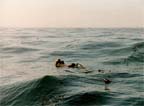|

|
Olympic Coast National Marine
Sanctuary occupies one of the most productive
regions of the planet-the North Pacific Temperate
zone. ...click image for more... (photo:
Nancy Sefton)
|
|

|
Bull kelp (Nereocystis
leutkeana) forms a critical habitat in Olympic
Coast National Marine Sanctuary. Its hollow stems
grow quickly, afixed to...click image for
more... (photo: Steve Fisher)
|
|

|
Ochre sea stars (Pisaster
ochraceus) are voracious predators in the
intertidal zone. Feeding on mussels and other
mollusks, they limit the range of these species.
(photo: Nancy Sefton)
|
|

|
Humpback whales (Megaptera
novaeangliae) visit the Sanctuary during spring
and summer months, congregating to feed over
...click image for more... (photo: Olympic
Coast NMS)
|
|

|
Most killer whales
(Orcinus orca) in the Sanctuary belong to
groups that migrate into the inner waters of Puget
Sound and Geogria Strait....click image for
more.... (photo: Olympic Coast NMS)
|
|

|
Northern sea lions
(Eumetopias jubatus) use haul-outs on many
offshore rocks and island. (photo: Steve
Fisher)
|
|

|
Common farther offshore
Pacific white-sided dolphins (Lagenorhynchus
obliquidens) congregate in large pods. (photo:
Olympic Coast NMS)
|
|

|
The orange-spotted nudibranch
(Triopha catalinae) is a mollusc without a
shell. Sometimes called "sea slugs," they feed on
minute organisms the..click image for
more... (photo: Steve Fisher)
|
|

|
Echinoderms-"spiny
skin"-represent an important group of invertebrates
in Sanctuary waters. The purple and red sea urchins
...click image for more... (photo: Nancy
Sefton)
|
|

|
Giant ocean sunfish (Mola
mola) often reach eight feet in length. These
odd-looking fish swim lazily through the water,
feeding primarily on jelly fish. (photo: Steve
Fisher)
|
|

|
China rockfish (Sebastes
nebulosus) are common nearshore fish that
inhabit rocky reefs and kelp beds of the Sanctuary.
(photo: Steve Fisher)
|
|

|
Sea anemones (Tealia
sp.) reflect the broad diversity of organisms
that are part of the marine ecosystem, yet play no
practical significant role in the lives of humans.
Nevertheless, we marvel at their beauty and
compexity and recognize their role in the marine
life support system. (photo: Steve
Fisher)
|
|

|
Two species of octopus are
common in Olympic Coast NMS. This small octopus
(Octopus rubescens) rarely exceeds 6 inches
in length. It's relative, ...click image for
more... (photo: Steve Fisher)
|
|

|
Clownlike in appearance,
tufted puffins (Fraturcula cirrhata) nest on
a few islands within the Sanctuary. Their numbers
have dwindled ..click image for more...
(photo: Olympic Coast NMS)
|
|

|
Common murres (Uria
aalge) in Olympic Coast NMS use only one
island-Tatoosh Island for nesting. In just a
decade, murre nesting ...click image for
more... (photo: Olympic Coast NMS)
|
|

|
Common murres (Uria
aalge) nest in the densest colonies of all
seabirds. Females lay one egg per season, holdin
the large pointed egg ...click image for more...
(photo: Olympic Coast NMS)
|
|

|
Sea otters (Enhydra
lutris) were hunted to extinction in Washington
in the early 1900s. Otters from Alaska were
reintroduced in 1969 and 1970 ...click image for
more... (photo: Olympic Coast NMS)
|





